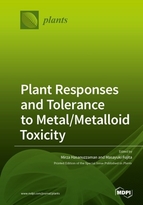Plant Responses and Tolerance to Metal/Metalloid Toxicity
A special issue of Plants (ISSN 2223-7747).
Deadline for manuscript submissions: closed (30 November 2019) | Viewed by 111820
Special Issue Editors
Interests: antioxidants; abiotic stress tolerance; plant metabolites; ROS signaling
Special Issues, Collections and Topics in MDPI journals
Interests: plant stress physiology; plant biochemistry; abiotic stress
Special Issues, Collections and Topics in MDPI journals
Special Issue Information
Dear Colleagues,
In the industrial era, the most important and potential threats to crop production are abiotic stresses. Among them, toxic metal stress is one of the major concerns. The growing population and fast industrialization coincide, resulting in the generation and dissemination of huge amounts of toxic metals in the environment. Toxic metals and metalloids result in growth reduction, altered physiology, and metabolisms, and diminish cellular integrity. Toxic metals also alter the redox homeostasis by influencing the reactive oxygen species generation. They also interfere with the nutrient and water uptake. As a result, both the crop yield and quality are hampered. Considering these effects, plant biologists, breeders, and agronomists are working to find approaches to enhancing plants’ tolerance to metal/metalloid toxicity. Remarkable progress has been made in understanding the metal chelation, antioxidant defense, and phytoremediation. A number of biotechnological tools and molecular approaches also contribute to such developments. In this Special Issue, we will publish reviews, mini-reviews, and research articles focusing on plant responses and their tolerance to metal/metalloid stress.
Dr. Mirza Hasanuzzaman
Prof. Dr. Masayuki Fujita
Guest Editor
Manuscript Submission Information
Manuscripts should be submitted online at www.mdpi.com by registering and logging in to this website. Once you are registered, click here to go to the submission form. Manuscripts can be submitted until the deadline. All submissions that pass pre-check are peer-reviewed. Accepted papers will be published continuously in the journal (as soon as accepted) and will be listed together on the special issue website. Research articles, review articles as well as short communications are invited. For planned papers, a title and short abstract (about 100 words) can be sent to the Editorial Office for announcement on this website.
Submitted manuscripts should not have been published previously, nor be under consideration for publication elsewhere (except conference proceedings papers). All manuscripts are thoroughly refereed through a single-blind peer-review process. A guide for authors and other relevant information for submission of manuscripts is available on the Instructions for Authors page. Plants is an international peer-reviewed open access semimonthly journal published by MDPI.
Please visit the Instructions for Authors page before submitting a manuscript. The Article Processing Charge (APC) for publication in this open access journal is 2700 CHF (Swiss Francs). Submitted papers should be well formatted and use good English. Authors may use MDPI's English editing service prior to publication or during author revisions.
Related Special Issues
- Plant Responses and Tolerance to Metal/Metalloid Toxicity Ⅱ in Plants (12 articles)
- Plant Responses and Tolerance to Metal/Metalloid Toxicity III in Plants (1 article)








